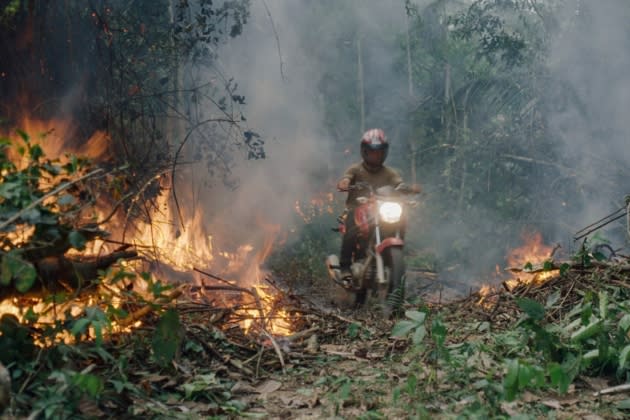‘The Territory’ Review: Indigenous Brazilians Stand Their Ground in an Urgent Environmental Docu-Thriller

Dual forces of climate change and cultural genocide overlap to devastating effect in “The Territory,” threatening not just a native community but a wider ecosystem — and cheered on by the actively hostile powers that be. Riveting and despairing in equal measure, freshman director Alex Pritz’s documentary immerses us over the course of three years in the lives, livelihoods and dwindling homeland of the Indigenous Uru-eu-wau-wau people, whose supposedly protected patch of Amazon rainforest is under attack from all sides by farmers, miners and settlers who think nothing of deforesting swaths of jungle that don’t belong to them.
For the Uru-eu-wau-wau, themselves rapidly diminishing in number, fighting back is essential but ugly, and anybody hoping for a comfortingly inspirational takeaway from “The Territory” may be disappointed. Instead, this short, sharply crafted Sundance premiere makes an impact with both its bleak, blunt messaging and its muscular formal construction, as the turf war in question takes on the heated urgency of a thriller. And while the presence of Darren Aronofsky as a producer may be an additional draw to prospective distributors for this National Geographic-style doc, more telling production credits here go to the Uru-eu-wau-wau themselves. Not content merely to be sympathetic victims under the gaze of the camera, they often wield it themselves, and the film benefits from their righteously inflamed point of view.
More from Variety
“The Amazon is not just the heart of Brazil, but of the whole world.” So says Bitate, an 18-year-old Uru-eu-wau-wau chosen by his elders to lead the community’s outward-facing Jupau Association — responsibility for defending their land from opposing forces thus coming to rest on his slender shoulders. The Amazon is certainly the whole world he has ever known, even as it visibly shrinks around him. Onscreen maps and graphics repeatedly show how the rainforest’s green abundance has ceded acreage in recent decades to treeless cattle-farm country, among other industrial victors. And with the land, lives have fallen away too: An introductory title card informs us that the Uru-eu-wau-wau now number a scant 200 people, down from thousands in the 1980s, when the Brazilian government first “contacted” the tribe.
That euphemistic choice of verb carries a chill, drawing a clear line from the past to the present-day government’s open war on Brazil’s Indigenous population, with far-right President Jair Bolsonaro promising his voters that “there won’t be one inch of Indigenous land left” by the end of his genocidal regime. Bitate and his people watch broadcasts of the President’s bile not with shock but a disconsolate shrug. Whether it’s been spoken aloud by the politicians in power or not, they’ve been living with the effects of this philosophy for some time. Veteran environmental activist Neidinha Bandeira is long past the point of idealistically trying to change hearts and minds: As she mentors Bitate and establishes an independent media outlet for the Uru-eu-wau-wau, straight-up survival is the first priority.
With more urgent stakes come more visceral tactics. Violence is doled out from both sides of the territory’s challenged border, as Carlos Rojas Felice’s editing hits a rattling procedural rhythm. Leading the charge on the Uru-eu-wau-wau is the Association of Rio Bonito, a ruthless collective of land invaders convinced that “the Indians” have too much. Matters reach a head when respected Uru-eu-wau-wau member Ari is killed in the clashes, though no peace talks are forthcoming. In an atmosphere of escalating terror — with Neidinha at the receiving end of repeated anonymous threats — the conflict shifts into fire-with-fire mode. (Sometimes quite literally so, as the Indigenous warriors resort to burning invaders’ belongings on their scorched, deforested land.)
It’s hard to see how any of this will end well, particularly as long as Brazil’s leaders keep advocating for such carnage to the approval of baying crowds. (Invasions of Indigenous territory in Brazil doubled in 2021, we are told at the film’s close.) Bright, fierce and conscientious even as he’s thrust too early into a role of unenviable leadership, Bitate symbolizes youthful defiance within an endangered population. But it’s hard not to wonder what kind of world his successors will inherit — both at the micro level, as the Uru-eu-wau-wau’s island of Amazonian green amid gets ever smaller amid encroaching industrial gray, and the bigger ecological picture. “How many trees do we lose that could hold the cure to a disease?” asks an anguished Neidinha, entirely rhetorically.
An accomplished documentary cinematographer who brought sleek visual panache to the Kenyan poaching study “When Lambs Become Lions” and Matthew Heineman’s recent “The First Wave,” Pritz shares camera duties here with tribe member Tangae Uru-eu-wau-wau, who brings tense in-the-moment immediacy to footage effectively shot from the frontline of this land battle. Elsewhere, “The Territory” is handsome without resting unduly on the natural beauty of its imperiled landscape, though iridescent closeups of plant and insect activity make clear the larger circle of life at stake here.
Best of Variety
Sign up for Variety’s Newsletter. For the latest news, follow us on Facebook, Twitter, and Instagram.